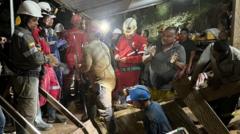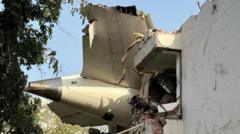As the 2025 climbing season approaches, the introduction of drones to assist Sherpas with load transport on Mount Everest could signify a transformative leap in mountain guiding, with the potential to reduce risks and streamline operations.
Drones to Assist Sherpas in Heavy Load Transport on Everest

Drones to Assist Sherpas in Heavy Load Transport on Everest
Innovative drones aim to enhance safety and efficiency for Sherpas during climbing season at Mount Everest.
In a pioneering effort, expedition companies are ready to deploy drones this climbing season on Mount Everest, aimed at lightening the heavy loads traditionally carried by Sherpas, who face perilous conditions at great altitudes. These drones will be capable of airlifting up to 35 pounds, a substantial load that often includes climbing gear, ladders, and even waste that accumulates on the mountain. With the ability to transport these items in mere minutes instead of the seven hours it takes on foot, the drone initiative could greatly enhance the operational efficiency and safety of the Sherpa community.
“This technology minimizes the dangers faced by Sherpas, who work in some of the harshest environments,” remarked Tshering Sherpa from the Sagarmatha Pollution Control Committee, emphasizing the hazardous conditions accentuated by climate change and increased incidents of snowmelt. The pilot project involving two drones, gifted by a Chinese manufacturer, has been undergoing testing for over a year, and this season's trials represent a pivotal moment for the Sherpa community.
In addition to climbing gear, the drones may also facilitate the delivery of essential supplies such as oxygen cylinders and potentially even hot meals, providing both practical support and morale-boosting sustenance for climbers and guides alike. Although the initial investment in drones is considerable, proponents assert that their long-term benefits will ultimately offset operational expenses for expedition agencies.
As mountain climbing continues to adapt to both the challenges posed by climate change and the evolving landscape of technology, the integration of drones could set a new standard for safety and efficiency in one of the world's most treacherous environments. The success of this initiative could encourage further investment in drone technology, reshaping the future of high-altitude expeditions.
“This technology minimizes the dangers faced by Sherpas, who work in some of the harshest environments,” remarked Tshering Sherpa from the Sagarmatha Pollution Control Committee, emphasizing the hazardous conditions accentuated by climate change and increased incidents of snowmelt. The pilot project involving two drones, gifted by a Chinese manufacturer, has been undergoing testing for over a year, and this season's trials represent a pivotal moment for the Sherpa community.
In addition to climbing gear, the drones may also facilitate the delivery of essential supplies such as oxygen cylinders and potentially even hot meals, providing both practical support and morale-boosting sustenance for climbers and guides alike. Although the initial investment in drones is considerable, proponents assert that their long-term benefits will ultimately offset operational expenses for expedition agencies.
As mountain climbing continues to adapt to both the challenges posed by climate change and the evolving landscape of technology, the integration of drones could set a new standard for safety and efficiency in one of the world's most treacherous environments. The success of this initiative could encourage further investment in drone technology, reshaping the future of high-altitude expeditions.




















